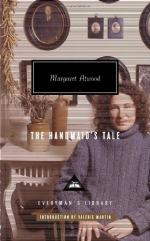|
This section contains 6,113 words (approx. 21 pages at 300 words per page) |

|
SOURCE: “‘Is There No Balm in Gilead?’ Biblical Intertext in Margaret Atwood's The Handmaid's Tale,” in Literature and Theology at Century's End, edited by Gregory Salyer and Robert Detweiler, Scholars Press, 1995, pp. 215-33.
In the following essay, Filipczak examines the significance of the Bible as a tool of institutionalized oppression and the biblical parallels and interpretation as seen in The Handmaid's Tale.
“Tu crois que cést l'oiseau qui est libre. Tu te trompes; cést la fleur …” says Jacques Derrida in one of his essays. Freedom is asserted in the cycle of defying and accepting one's roots. The Handmaid's Tale is haunted by the echo of cultural origins, as manifest via the insidious presence of biblical images in the text. Rooted in the English language legacy of the “Great Code,” Atwood's book attempts to destroy these roots via the demonic misrepresentation of Judaic-Christian religion. In the dystopic...
|
This section contains 6,113 words (approx. 21 pages at 300 words per page) |

|


